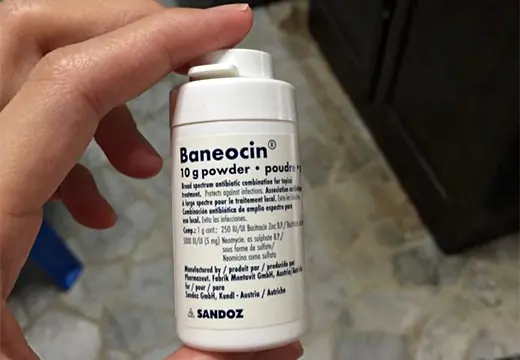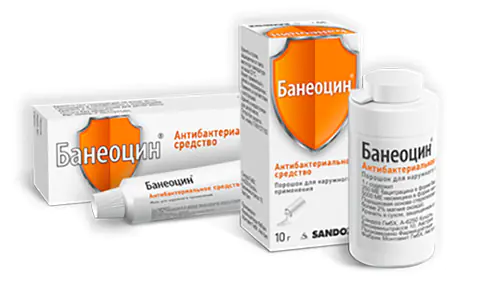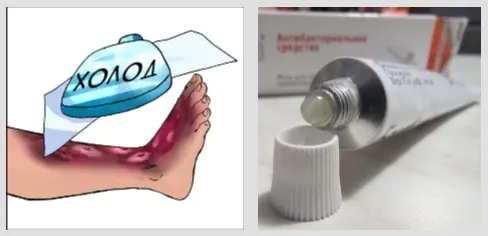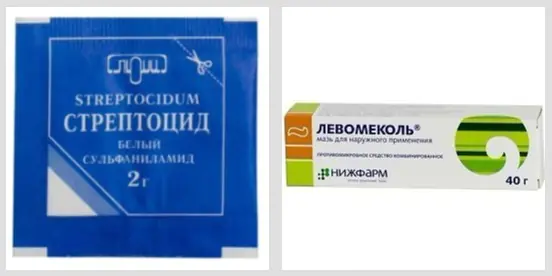An effective medication intended to relieve dermatological inflammation, speedy healing of skin lesions, wounds and abrasions is the antimicrobial and antibacterial ointment Baneocin.
Release form and composition
This drug is made in the form of a powder or ointment and is intended for external use. The ointment has the appearance of a homogeneous plastic mass of a yellowish tint and an indistinct specific aroma. The medication is packaged in aluminum tubes of 5 or 20 g.
For one gram of medicine there is:
- Neomycin sulfate – 5000 IU (antibiotic complex – neomycin A, B and C);
- Bacitracin zinc – 250 IU (polypeptide antibiotic).
The active ingredients are supplemented with components such as sheep lanolin and white paraffin.
Pharmacological action and pharmacokinetics
Baneocin is a combination antibiotic used to slow down the production of proteins and membranes in bacterial cells, which has a detrimental effect on gram-positive and -negative microorganisms:
- Streptococcus;
- Staphylococcus;
- Beta-hemolytic streptococci.
The combined composition provides the medicine with a wide spectrum of action, since its components, combined together, have a greater effect compared to their separate use against pathogenic microflora.
Typically, this ointment is well tolerated by humans and absorption does not occur even through damaged areas of the epidermis that contain a significant concentration of the active ingredients of the drug.
Indications for use
The drug shows good effectiveness in eliminating focal dermatological infections, such as:
- Deep inflammation of the hair follicles;
- Staphylococcal chronic inflammation of hair follicles (sycosis);
- Purulent-necrotic inflammation of the skin in the area of the follicles and sebaceous glands;
- Furunculosis;
- Acute inflammation of the periungual fold;
- Purulent inflammation of the sweat glands.
Baneocin copes excellently with limited skin infections of a bacteriological nature:
- Burns of thermal origin;
- Abrasions, scratches;
- Cuts, wounds;
- Dermatoses;
- Eczema of secondary infection;
- Ulcerative lesions of the lower extremities;
- Contagious impetigo.
Along with the above indications, the ointment is actively prescribed during surgical interventions for organ and tissue transplantation, in cosmetology and plastic surgery, as a prophylactic drug.
Baneocin is also used for additional therapy after surgical interventions by applying it to a gauze pad when dressing surgical sutures, wounds, and bacterial infections of the external auditory canals.
Directions for use and dosage
Before first use, it is recommended to test the ointment for sensitivity to its active substances to prevent the occurrence of allergic reactions. If a few hours after applying a small amount of ointment to a sensitive area in the elbow or wrist area, a negative reaction does not occur, the medicine can be used on the affected areas.
The ointment is applied locally to damaged areas of the epidermis; a loose gauze bandage may be applied on top. The use of the drug is allowed up to three times a day; the permissible daily dosage of neomycin is one gram.
For children, the same standards for using the product apply as for adult patients. The duration of therapy is up to seven days; in some cases, according to indications, the doctor may prescribe a different duration of treatment with the medication, in which case the maximum daily dose is halved.
Contraindications
The limitation of the use of the drug is intolerance to its components. The ointment is not used to treat infectious lesions of the ear canal if there is existing damage to the eardrum.
Use is not permitted in cases of dysfunction of the vestibular apparatus, cochlear system, or pathologies of the excretory organs due to the risk of systemic absorption.
The ointment is not used for abnormalities in the functioning of the neuromuscular system, so as not to provoke disturbances in neuromuscular conduction.
Due to the antibiotics in the medication, it is prescribed with caution during pregnancy and lactation to avoid possible harm to the baby. Only a trained medical professional can evaluate the degree of benefit of a drug in comparison with the possible risks of its use.
There is no information about an overdose of Baneocin ointment, however, one should not neglect to comply with the dosage of the medicine recommended in the instructions for use.
Side effect
Long-term use of the ointment can cause the following symptoms:
- Itching;
- Rash;
- Xeroderma (dry epidermis);
- Redness (hyperemia) of the skin.
These symptoms occur in rare cases, are allergic in nature and disappear after discontinuation of the drug. Side effects are often observed together with intolerance to aminoglycoside group antibiotics.
Important! With prolonged use of ointments on a large surface of damaged skin, due to the absorption of active components, specific complications can occur.
Overdose
There is no information on reported cases of overdose.
Interaction with alcohol and other drugs
In case of manifestations of systemic absorption, combined use of cephalosporins and aminoglycosides with antibacterial medications increases the possibility of neurotoxic reactions.
Symptoms of blockade of neuromuscular fiber conduction may occur in persons taking anesthetics or muscle relaxants against the background of systemic absorption of Baneocin.
Taking the drug together with diuretics can cause nephrotoxicity or ototoxicity.
Special instructions
If superinfection or signs of hypersensitivity to the components of the drug occur, treatment is stopped immediately.
Analogs
According to the pharmacological group (aminoglycosides in combinations), analogues of Baneocin ointment are Polygynax and Polygynax Virgo.
Wound healing powder Baneocin is an antiseptic that is used to accelerate the process of epithelial restoration and prevent complications. The complex drug is active against various types of opportunistic and pathogenic flora. It is used topically, strictly according to the instructions and after consultation with a specialist.

Properties of the drug Baneocin and its composition
The main components of the drug are bacitracin zinc and neomycin. The powder is used for local treatment of open wound surfaces and healing.
Effect of the drug Baneocin:
- Bacitracin zinc is a polypeptide antibiotic. Active against gram-positive bacteria. Suppresses staphylococcus, streptococcus, clostridia, treponema, corynebacteria. The powder affects some gram-negative microorganisms, including actinomycetes and fusobacteria. Resistance to bacitracin is rare.
- Neomycin is an aminoglycoside antibiotic that promotes healing. It has a bactericidal effect and destroys the bacterial cell. Aggressive against the vast majority of microorganisms. Resistance practically does not develop.
Active substances enhance each other. This promotes healing of the damaged surface.
When treating a wound, the absorption of Baneocin is minimal - it does not have a systemic effect on the body. The use of a dosage form for local application prevents the development of system-wide side effects and addiction to the drug.

Release form of Baneocin and the advantages of each of them
The products are available in 2 types. The dosages of active substances in them are the same.
The ointment is yellowish, of uniform consistency. A complete analogue of the powder in composition and quantity of active ingredients.
The indication for use is the presence of lesions infected with pathogenic flora and the acceleration of their healing.
The ointment helps soften tissue; it is advisable to prescribe it to patients with wounds that heal with secondary intention.
Baneocin powder is yellowish, reminiscent of powder or powder. This dosage form is mainly used for healing of weeping wounds and sutures, when treating areas covered with mucous membrane, such as the perineum.
The drugs in both dosage forms have a bactericidal effect. Used to heal various types of damage. The choice of the type of remedy is the prerogative of the doctor.
How to use the powder correctly
For purulent wounds and other injuries, Baneocin is applied in powder form 2-4 times a day, in the form of an ointment - 2-3 times a day. If necessary, the tissues are pre-treated with a solution of hydrogen peroxide. This allows you to remove remaining pus and impurities.
Powder the affected surface with the product. The total volume of tissue treated should not exceed an area equal to the size of the patient's palm. According to indications, after the procedure the wound is covered with a sterile bandage for healing.
The duration of the course is 7 days. If there is no effect, adjustment of treatment is recommended.

How to treat an umbilical wound
The powder is approved for use in children during the neonatal period. The drug is used only according to indications and in agreement with the pediatrician. In most cases, it is enough to use less serious antibacterial drugs to heal the navel.
The use of Baneocin for treatment is advisable:
- if the wound does not heal for a long time;
- the navel becomes wet, crusts form;
- the appearance of an unpleasant odor;
- the presence of purulent masses in the wound during healing;
- general poor condition of the baby, indicating an inflammatory process in the navel.
The pediatrician explains the procedure for treating with an antibacterial drug. Wound powder Baneocin is approved for healing the navel in the first days of a child’s life.
Standard rules for purulent wounds:
- Wash your hands, remove the diaper.
- Wash your stomach with boiled water at room temperature. The use of baby soap is allowed.
- Treat the navel with hydrogen peroxide. Blot off excess.
- Sprinkle the powder on the affected area.
- If possible, leave the child without a diaper or clothes. Allow the skin to absorb the healing agent.
The number of wound treatments with Baneocin is prescribed by the doctor. The standard recommendation in the instructions is 2–5 times a day. The duration of treatment should not exceed 7 days.
Does using Baneocin powder cause scars?
Powder and ointment are intended for the treatment of purulent, weeping surfaces. When pathogenic organisms are activated, the intensity of inflammation increases, and foci of necrosis may form. A long purulent process contributes to extensive tissue destruction, which ends in the formation of unaesthetic scars.
Surface cleanliness increases the rate of granulation, epithelialization and healing. The risk of coarse scar tissue formation is reduced.
Patient reviews of powder for injured skin areas do not mention that Baneocin on an open wound leads to scars. Users write about the rapid subsidence of the inflammatory process and suppuration.
Doctors' opinions about the drug are positive. Experts note the high speed of cleaning from necrotic tissue, ease of use, and a minimum of patient suffering during treatment and treatment. The components of the powder do not contribute to the formation of keloid scars. The formation of large sutures after the use of Baneocin for wound healing is not found in the medical literature.
Contraindications and possible complications
It is prohibited to prescribe Baneocin powder or ointment:
- if you have had an allergic reaction in the past to components of the drug or other aminoglycoside antibiotics;
- Patients with extensive wounds have kidney disease. The active substances are absorbed and have a nephrotoxic effect;
- severe muscle weakness;
- with blood acidification during healing;
- patients with perforation of the tympanic septum;
- closed wounds and sutures after surgical treatment.
Possible complications arise when using the drug independently. Baneocin has nephro- and ototoxic effects. It manifests itself with significant absorption of the active components of the powder or ointment. Increased absorption occurs with extensive damage and prolonged use of the drug for healing.
Baneocin is prescribed for the treatment of purulent, weeping lesions. There is no need to treat abrasions or pimples with it. In this case, you can use less active agents with fewer contraindications. A doctor must prescribe a drug for wound healing.
Throughout life, every person is faced with wounds, burns and other injuries more than once. Moreover, if the situation is not quite complex, in most cases treatment occurs at home using the products provided in the home medicine cabinet. The main thing is that they are selected correctly and are at hand at the most opportune moment. These drugs include Baneocin, which helps prevent the development of wound infections and speed up the healing of wounds and burns.
Forms of release of the drug

Baneocin is used only for external use and has two release forms.
- Powder for external use 10g.
- Ointment for external use 5g, 20g.
Pharmacological properties and composition of the drug
Baneocin is a combination product that contains two main active ingredients, bacitracin and neomycin, which have an antibacterial effect. In this case, bacitracin inhibits the synthesis of bacterial cell walls, and neomycin prevents the formation of their protein elements. The main auxiliary components of the ointment are white paraffin and lanolin, and corn starch powder. They ensure the most comfortable use of the drug and help preserve its properties throughout the entire shelf life.
Instructions for use of the drug
For burns from boiling water, a cut finger and other household injuries accompanied by damage to the skin, Baneocin can be used on an open wound. It is easy to apply and does not cause discomfort. If necessary, a gauze bandage is applied on top.
The frequency of use of Baneocin powder in children and adults is 2-4 times a day, Baneocin ointment - 2-3 times a day.
In burn patients, if more than 20% of the body is damaged, Baneocin powder is used no more than once a day.
This is associated with the risk of side effects due to the high degree of absorption of the drug.
In most cases, recovery occurs within 7 days from the start of using the drug.
If there is significant damage to the skin, a second course of treatment may be prescribed.
The price of the drug Baneocin powder is on average 370 rubles, ointments in tubes of 20 g. – 360 rub., and in tubes of 5 g. – 180 rub. Dispensed without a doctor's prescription.
Proper treatment for wounds and burns

Much depends on how correctly we are able to navigate a given situation. This is especially true for providing first aid to yourself and your loved ones. Therefore, if burns or wounds occur, you should not hope that everything will go away on its own. An open wound is the main route for pathogenic bacteria to enter the body.
In the event of burns, the first step is to eliminate the damaging agent (cool the area in case of a thermal burn or remove the substance that is the source of a chemical burn from the surface of the skin). After this, if possible, it is necessary to clean the skin of impurities, and then treat the surface around the wound with an antiseptic and apply a drug to the wound that draws out pus, prevents the development of bacterial infection and promotes speedy healing.
Using oils or puncturing blisters is strictly prohibited.
A bandage is applied to the damaged surface as needed.
The wound surface is treated in a similar way.
In all cases, difficult situations are a reason to immediately seek specialized medical help.
Baneocin: ointment or powder
Despite the presence of the same active ingredients and similar properties, Baneocin ointment and powder are used in different situations. So, for the treatment of weeping wounds, powder or, as the common people say, powder, will be most relevant. It is also more suitable for children’s abrasions, scratches, and bruises, since it does not require direct contact with the damaged surface. Secondary wound infections, boils, folliculitis and closed suppurations should be treated with ointment. For local prevention of infections after dermatological procedures and surgical interventions, both drugs can be used.
Main contraindications for use
There are not many contraindications to the use of Baneocin. These include:
- Hypersensitivity to the main active ingredients (neomycin, bacitracin) or other aminoglycosides;
- Eye diseases (relevant for powder);
- Significant impairment of renal excretory function;
- Extensive skin lesions.
Analogs

The main analogues of Baneocin include Streptocide (powder) and Levomekol (ointment), which have similar indications for use. Despite the wide spectrum of action of Baneocin, its comparative safety and ease of administration, in some cases other drugs can be used. So, in case of extensive skin damage, it is better to use Levomekol ointment, and in the presence of infections resistant to neomycin and bacitracin (components of Baneocin) - Streptocid. In the latter case, it is the difference in the composition of the drugs that plays a decisive role.
Reviews from consumers and experts
The number of opinions that exist regarding Baneocin varies. However, most of them are positive. Consumers and specialists who have experience using the drug return to it again and again. This is facilitated by the low number of contraindications, its high efficiency and safety. In addition, the drug is affordable and easy to use.
The amount of time spent treating wounds and burns largely depends on the correct medical care provided and the quality of the drugs used. Over many years, Baneocin has proven its effectiveness and safety in this area. The possibility of using the drug in children and adults makes it an indispensable component of the home first aid kit of every person who cares about their health.
Features of the use of the drug Baneocin for wounds and burns



